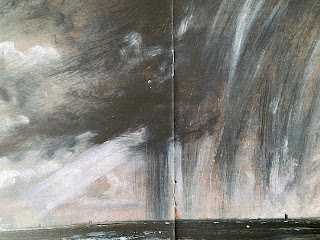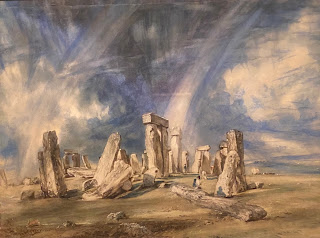Looking Outside the Chocolate Box: Noticing John Constable
I stood, in chilly early December 2021, on the edge of the water where Constable had set his celebrated painting now called The Haywain, but originally and more reservedly, Landscape: Noon.
The conditions in which I stood and looked and those represented in the painting could not be more opposed. Constable’s weather is summery. There’s an outlook across the river Stour to a vista of ripe fields, and the eponymous cart and horses stand peacefully in the waters. For me, there was no romantic Haywain in view (but a pair of swans a little way downstream- a downstream that is not apparent in the painting: either the course of the river has changed , or Constable changed it for artistic effect), and the vista over the fields is now blocked by a flood bank and trees.
However, the foreground framing for the painting remains. This contains, famously, the farmer’s house on the left and a spit of land on the right. And the foreground water – which immediately one realises is not the main flow of the river, which is beyond the spit, but a side eddy or pond. A viewer of the painter might reasonably suppose that the river comes in from the bottom right of the scene. That is in fact dry land, whence the Haywain has trundled.
It’s odd, coming to a place like Flatford Mill (now owned by the National Trust), where the main purpose is to share the perspectives of a great painter. Appreciation of the paintings of 200 years ago does not depend one jot, or lick of varnish, on standing on the edge of water and going “aah, just like in the painting”. Nonetheless, it was intriguing to be there, and the “aah” moment cannot be denied.
Perhaps the connection is this: Constable was inspired by, and profoundly infused with love of, his native places. That some of the most significant of those places are still here, well conserved, is a collateral triumph of his art, one seldom achieved by a landscape painter.
The visit to Flatford was the fifth of my recent encounters with Constable. I have to confess that it is only this year, 2021, that I have started to study and appreciate Constable’s art. Like many, I suspect, I had lazily associated him with sentimental chocolate box images. It is true that some of his work lends itself to sentimental appropriation. But that is not necessarily the truth of those works.
Two of my other encounters have been at exhibitions – “Early Constable” in Ipswich, the artist’s nearest big town in his youth; and “Late Constable” at the Royal Academy. (Alas, there is as yet no “Middle Constable”.)
But, first, in the summer of 2021 I followed a Courtauld course on Turner and Constable. Though at the time more taken with the varied brilliance of Turner (an admiration reinforced by the Autumn Tate exhibition, “Turner’s Modern World”), I began to appreciate Constable’s brushwork skills, his adventures in watercolour, his close observation of natural features. But, above all, there’s his intense, sometimes mystical engagement with his subjects. Especially for him as an artist, as for his contemporary Wordsworth in poetry, landscapes are living, felt things. As the Lake District was to Wordsworth (“fostered alike by beauty and by fear”), so was the more benign Dedham Vale to Constable.
This appreciation was reinforced by a later course on British Landscape Painting put on by the excellent Cambridge Art Tours - which also organised the the visit to Ipswich and Flatford.
The Royal Academy exhibition takes us from the painstaking development of the last of the “Six Footers”, those large, crowded, well observed rural canvasses that form the corpus of the chocolate box images – and leaps forward to the looming melancholy of Hadleigh Castle,
painted the year Constable’s wife died, via the astonishing impressionism of Rainstorm Over The Sea.
Finally there are the unsettling depictions of Stonehenge and Salisbury, and other monuments, rendered in strange, ethereal rainbow light.
The “Early Constable” at Ipswich (in the interesting Tudor Christchurch Mansion) is much less the blockbuster. It contains relatively few finished oils by Constable himself, but a lot of sketches and small watercolours.
There’s a very interesting array of paintings by local artists who were contemporaries and friends of the young Constable, notably George Frost.
Two pieces by Constable stand out: small oil pictures of the gardens at his parents’ house. In one of the gardens his mother suffered the stroke that would lead to her death. These paintings always remained in Constable’s possession. Through representation of Place, attachment to Person is preserved.
So back to the present-day banks of the Stour at Flatford Mill. Constable took from, and gave to, this landscape his vision of it and feeling for it. He brought that rich and profound combination onto his canvasses. The artistic effect of that cannot be recaptured by the curious visitor to the National Trust estate. But we are grateful that a beautiful spot, with deep associations, has been preserved, as best as may be for a tourist destination.
December 2021









No comments:
Post a Comment